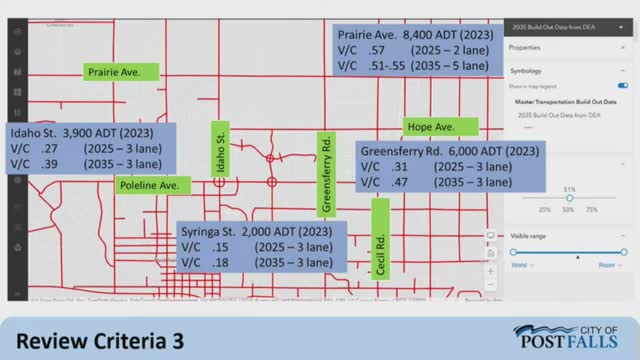City plans major road upgrades to tackle future traffic surge
November 05, 2024 | Post Falls, Kootenai County, Idaho
This article was created by AI summarizing key points discussed. AI makes mistakes, so for full details and context, please refer to the video of the full meeting. Please report any errors so we can fix them. Report an error »

In a recent government meeting, officials discussed the implications of a new transportation master plan aimed at managing growth and traffic in the Post Falls area. The plan seeks to streamline development processes by minimizing the need for redundant traffic studies, thereby saving time and costs for developers and potentially lowering housing prices.
Key roads affected by the proposed developments include Idaho Street, Greens Ferry Road, Prairie Avenue, and Suringa Road. Currently, Prairie Avenue experiences approximately 3,400 vehicle trips per day, operating at 57% of its capacity. Projections indicate that by 2035, this road will need to be expanded to a five-lane configuration to accommodate anticipated traffic increases, which could reach 90% of capacity without improvements.
Greens Ferry Road, currently a three-lane road, is expected to remain at around 47% capacity by 2035, while Idaho Street is projected to operate at 40% capacity. Suringa Street, classified as a minor collector, currently handles about 2,000 vehicles daily, which is significantly below its desired capacity of 5,000 vehicles. Officials anticipate that traffic on Suringa will rise to approximately 3,000 vehicles per day by 2035, still within acceptable limits.
The meeting also highlighted the classification of Penrose Avenue as a major collector road, despite its current low usage. Officials explained that this designation is based on long-term planning to connect Idaho Street to State Highway 41, which is expected to increase traffic flow in the future.
Concerns were raised about the safety and accessibility of intersections along these roads, particularly regarding left-hand turns. Officials assured that future developments would include necessary configurations to facilitate safe turning movements, even in areas where landscaping limits lane width.
The discussion concluded with a commitment to ongoing updates to the transportation master plan, ensuring that it reflects current and future traffic patterns and safety needs. The city plans to utilize impact fees from new developments to fund necessary road improvements, including traffic signals and road widenings, to mitigate potential congestion and enhance safety in the area.
Key roads affected by the proposed developments include Idaho Street, Greens Ferry Road, Prairie Avenue, and Suringa Road. Currently, Prairie Avenue experiences approximately 3,400 vehicle trips per day, operating at 57% of its capacity. Projections indicate that by 2035, this road will need to be expanded to a five-lane configuration to accommodate anticipated traffic increases, which could reach 90% of capacity without improvements.
Greens Ferry Road, currently a three-lane road, is expected to remain at around 47% capacity by 2035, while Idaho Street is projected to operate at 40% capacity. Suringa Street, classified as a minor collector, currently handles about 2,000 vehicles daily, which is significantly below its desired capacity of 5,000 vehicles. Officials anticipate that traffic on Suringa will rise to approximately 3,000 vehicles per day by 2035, still within acceptable limits.
The meeting also highlighted the classification of Penrose Avenue as a major collector road, despite its current low usage. Officials explained that this designation is based on long-term planning to connect Idaho Street to State Highway 41, which is expected to increase traffic flow in the future.
Concerns were raised about the safety and accessibility of intersections along these roads, particularly regarding left-hand turns. Officials assured that future developments would include necessary configurations to facilitate safe turning movements, even in areas where landscaping limits lane width.
The discussion concluded with a commitment to ongoing updates to the transportation master plan, ensuring that it reflects current and future traffic patterns and safety needs. The city plans to utilize impact fees from new developments to fund necessary road improvements, including traffic signals and road widenings, to mitigate potential congestion and enhance safety in the area.
View full meeting
This article is based on a recent meeting—watch the full video and explore the complete transcript for deeper insights into the discussion.
View full meeting